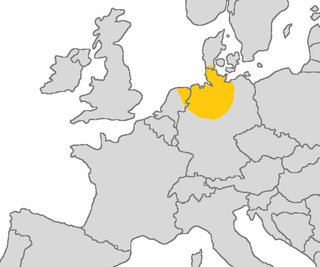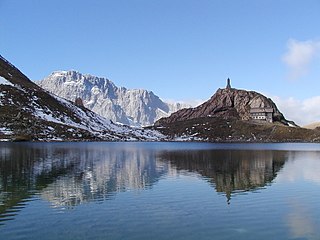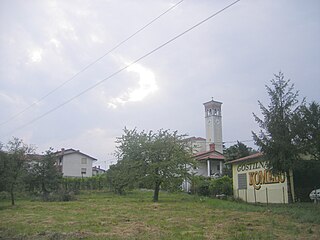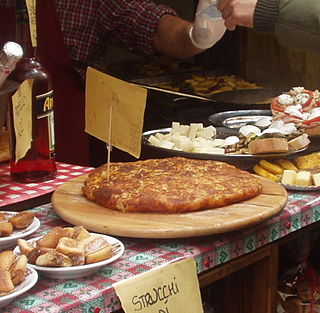Degano is an Eastern Alpine surname of Germanic-Friulian origin.

Eastern Alps is the name given to the eastern half of the Alps, usually defined as the area east of a line from Lake Constance and the Alpine Rhine valley up to the Splügen Pass at the Alpine divide and down the Liro River to Lake Como in the south. The peaks and mountain passes are lower compared to the Western Alps, while the range itself is broader and less arched.

The Germanic peoples were an indigenous ethnolinguistic group of Northern European origin identified by Roman-era authors as distinct from neighbouring Celtic peoples, and identified in modern scholarship as speakers, at least for the most part, of early Germanic languages.
Friulian or Friulan is a Romance language belonging to the Rhaeto-Romance family, spoken in the Friuli region of northeastern Italy. Friulian has around 600,000 speakers, the vast majority of whom also speak Italian. It is sometimes called Eastern Ladin since it shares the same roots as Ladin, but, over the centuries, it has diverged under the influence of surrounding languages, including German, Italian, Venetian, and Slovene. Documents in Friulian are attested from the 11th century and poetry and literature date as far back as 1300. By the 20th century, there was a revival of interest in the language.
Its place of maximum frequency is the province of Udine, in the Alpine region of Friuli.

The province of Udine was a province in the autonomous region Friuli-Venezia Giulia of Italy, bordering Austria and Slovenia. Its capital was the city of Udine, which has a population of 99,242 inhabitants. It had a total population of 530,849 inhabitants over an area of 4,907.24 square kilometres (1,894.70 sq mi). The province was abolished on 30 September 2017.
It is a derivate of the evolution of the classic Old High German word " degan ".

Old High German is the earliest stage of the German language, conventionally covering the period from around 750 to 1050. There is no standardised or supra-regional form of German at this period, and Old High German is an umbrella term for the group of continental West Germanic dialects which underwent the set of consonantal changes called the Second Sound Shift.
The first documented use of "degano" as a substantive is observed in the epic poem "Hildebrandslied" of langobardic origin, written in Old High German with Old Saxon elements and dates back to c.ca 800 AD.

The Hildebrandslied is a heroic lay written in Old High German alliterative verse. It is the earliest poetic text in German, and it tells of the tragic encounter in battle between a father (Hildebrand) and a son (Hadubrand) who does not recognize him. It is the only surviving example in German of a genre which must have been important in the oral literature of the Germanic tribes.

Old Saxon, also known as Old Low German, was a Germanic language and the earliest recorded form of Low German. It is a West Germanic language, closely related to the Anglo-Frisian languages. It is documented from the 8th century until the 12th century, when it gradually evolved into Middle Low German. It was spoken throughout modern northwestern Germany, primarily in the coastal regions and in the eastern Netherlands by Saxons, a Germanic tribe who inhabited the region of Saxony. It partially shares Anglo-Frisian's Ingvaeonic nasal spirant law which sets it apart from Low Franconian and Irminonic languages, such as Dutch, Luxembourgish and German.
It could also derive from a dialectal use of the latin title " decanus ", or indicating the leader of a type of Swiss-Alpine territorial division "degagna".
Decanus means "chief of ten" in Late Latin. The term originated in the Roman army and became used thereafter for subaltern officials in the Byzantine Empire, as well as for various positions in the Church, whence derives the English title "dean".

Rhaeto-Romance, or Rhaetian, is a traditional subfamily of the Romance languages that is spoken in north and north-eastern Italy and in Switzerland. The name "Rhaeto-Romance" refers to the former Roman province of Rhaetia. The linguistic basis of the subfamily is discussed in the so-called Questione Ladina. The Rhaeto-Romance languages form a group of Romance languages in the Alps region of northern Italy and Switzerland. Initially studied by Italian Linguist Graziadio Ascoli in 1873, Ascoli found these languages to share a number of intricacies and believed they belonged to a specific linguistic group. What distinguishes Rhaeto-Romance languages from Italian and other Western languages are its phonemic vowel length, consonant formation, and a central rounded vowel series. A few notable examples of these languages are Romansh, Friulian and Ladin, which are officially recognized alongside German, French and Italian, by the Swiss and Italian governments respectively. In total there are about 660,000 speakers of the Rhaeto-Romance languages combined, the vast majority of whom speak Friulian at approximately half a million.
Degano (Dean in Friulian) is also a river having its source at 1039m a.s.l in the Carnic Alps in the comune of Forni Avoltri.

The Carnic Alps are a range of the Southern Limestone Alps in Austria and northeastern Italy. They are within Austrian East Tyrol and Carinthia, and Italian Friuli and marginally in Veneto of the Friuli-Venezia Giulia region.

Forni Avoltri is a comune (municipality) in the Province of Udine in the Italian region Friuli-Venezia Giulia, located about 130 kilometres (81 mi) northwest of Trieste and about 70 kilometres (43 mi) northwest of Udine, on the border with Austria. As of 31 December 2004, it had a population of 704 and an area of 80.8 square kilometres (31.2 sq mi).
Degano can also refer to Val Degano, one of the 7 valleys of the Alpine historical-geographic region of Carnia (Cjargne in Friulian).
Notable people with the surname include:
- Daniele Degano (born 1982), Italian footballer
- Enrico Degano (born 1976), Italian cyclist
| This page lists people with the surname Degano. If an internal link intending to refer to a specific person led you to this page, you may wish to change that link by adding the person's given name(s) to the link. |















